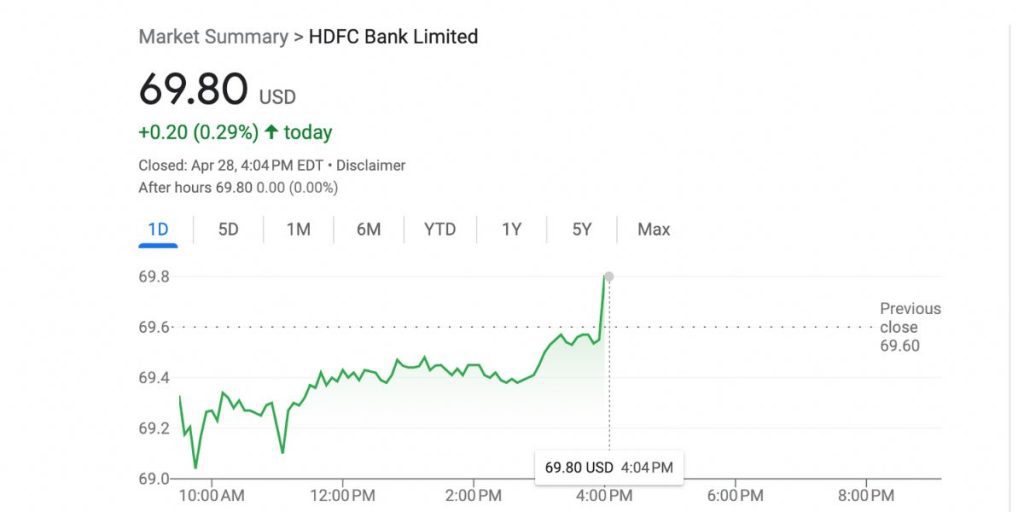HDFC share price, today, and history
HDFC Bank is a leading private sector bank in India that provides financial products and services to customers all over the country. The bank’s stock prices have gone through fluctuations over time, which reflects the various challenges and opportunities in the Indian banking industry.
In this article, we will take a closer look at the history of HDFC Bank’s share price, as well as its performance in recent years and the factors that are likely to impact its prospects
History of HDFC Bank’s Share Price
HDFC Bank was established in 1994 and its shares were listed for the first time on the Bombay Stock Exchange in 1995. Over time, the bank’s share price has seen considerable growth, which can be attributed to various factors such as impressive financial performance, an expanding customer base, and a formidable presence in the market.
During the period from 2000 to 2010, HDFC Bank witnessed notable growth in its share price, which rose from approximately INR 100 per share in 2000 to more than INR 2,000 per share by the conclusion of 2010. This growth was primarily a result of the bank’s solid financial performance, which included steady earnings growth and the upholding of a high level of asset quality.
The bank’s financial performance took a hit following the global financial crisis of 2008-09. In 2011, there was a significant decline in its share price, dropping from over INR 2,000 per share to about INR 500 per share by the end of the year. This was due to concerns about rising inflation, a decline in economic growth, and worries about the impact of global economic uncertainty on the Indian economy.
Afterward, HDFC Bank’s share price gradually improved, influenced by various factors such as the revival of the Indian economy, excellent financial performance, and the bank’s concentration on digital innovation and customer-focused schemes. At the end of 2019, the bank’s share price again exceeded INR 2,000 per share, reaching a peak of INR 2,489.95 in December of that year.
Like many companies worldwide, HDFC Bank’s share price was impacted by the COVID-19 pandemic in 2020. In March 2020, there was a sharp decline in the bank’s shares, dropping to INR 765 per share as investors became concerned about the potential effects of the pandemic on the Indian economy and banking sector.
HDFC Bank’s share price has gradually recovered due to various reasons, such as its promising financial performance, emphasis on digital innovation, and ability to adjust to market conditions.
Performance of HDFC Bank’s Share Price in Recent Years
Despite the challenges faced by the Indian banking sector, HDFC Bank’s share price has performed well in recent years. This can be attributed to various factors that include:
1. Strong Financial Performance –
HDFC Bank’s financial performance has been consistently impressive in recent years. The bank has experienced growth in earnings, deposits, and assets under management, leading to increased investor confidence and support for the bank’s share price.
2. Digital Innovation –
The Indian banking sector has witnessed HDFC Bank’s prominent role in digital innovation as they invest heavily in new technologies and digital channels. Their dedication to enhancing customer experience and driving growth through digital innovation has enabled them to stay competitive and ahead of the curve in the rapidly changing market.
Also Read:
3. Customer Focus –
The customer-centric approach of HDFC Bank, which involves offering tailored solutions and services to meet customers’ individual needs, has earned the bank a strong reputation in the market. This strategy has also helped the bank to bolster its customer base and achieve business growth.
4. Solid Reputation –
The market recognizes HDFC Bank for its strong brand image and impressive financial performance, which has resulted in favorable investor interest and continued growth of the bank’s share price.
5. Robust Risk Management –
The presence of a robust risk management framework at HDFC Bank has been effective in reducing the negative effects of market and economic volatility on the bank’s operations and financial performance. This has contributed to sustaining the trust of investors in the bank and has also had a positive impact on the performance of its share prices in the long run.
Although there were challenges and periods of volatility along the way, HDFC Bank’s share price has generally performed better than the broader market in recent years.
Factors that are Likely to Impact HDFC Bank’s Future Prospects
In the future, certain factors may affect HDFC Bank’s potential and the performance of its shares. Some important factors to keep an eye on include:
1. Economic Environment –
The Indian economy may face difficulties in the coming years due to persisting structural problems and a turbulent global economic climate. This could affect the overall banking sector, including HDFC Bank, and lead to a decline in the bank’s stock price performance.
2. Regulatory Environment –
The operations and profitability of banks in India are influenced by various regulations and policies. HDFC Bank’s financial performance and share price may be significantly affected by changes in regulatory policies.
3. Digital Innovation –
To stay competitive and meet customer needs, HDFC Bank must continue to invest in digital innovation and new technologies. If the Bank fails to keep up with changing market conditions and customer preferences, it may affect its growth prospects and share price performance.
4. Asset Quality –
The financial and share price performance of HDFC Bank heavily relies on the quality of its assets. If the quality of assets declines, for instance, an increase in non-performing assets, it might negatively affect the bank’s financial and share price performance.
5. Competition –
In India, the banking industry is very competitive due to various established players and new market entrants competing for market share. Therefore, HDFC Bank must keep up its efforts to innovate and distinguish itself to retain its competitive position and sustain growth in its business.
Conclusion:
Over the years, HDFC Bank’s share price has grown significantly due to factors such as strong financial performance, a growing customer base, and a solid reputation in the market. Despite facing some challenges, the bank has consistently performed well in recent years, outpacing the broader market and sustaining investor confidence.
In order to sustain its growth and ensure long-term benefits for shareholders, HDFC Bank must overcome various challenges and exploit opportunities in the coming years. The bank’s future depends on several factors like digital innovation, asset quality, competition, and changes in the economic and regulatory environment. To make wise investment choices and achieve maximum returns, investors should remain proactive and well-informed.







